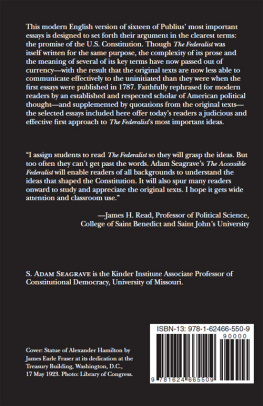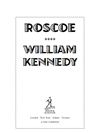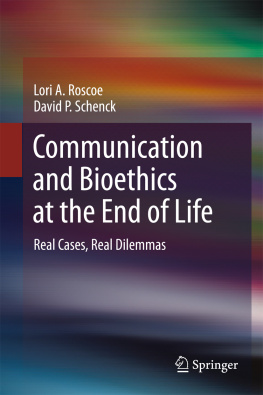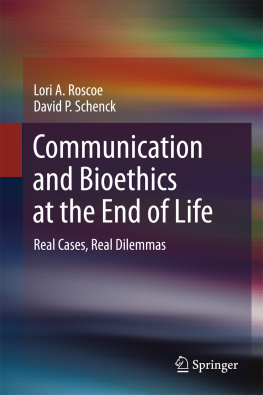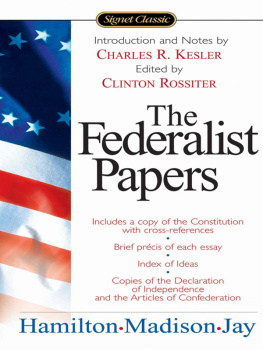First published 1965 by Transaction Publishers
Published 2017 by Routledge
2 Park Square, Milton Park, Abingdon, Oxon OX14 4RN
711 Third Avenue, New York, NY 10017, USA
Routledge is an imprint of the Taylor & Francis Group, an informa business
Copyright 1965 by Taylor & Francis.
All rights reserved. No part of this book may be reprinted or reproduced or utilised in any form or by any electronic, mechanical, or other means, now known or hereafter invented, including photocopying and recording, or in any information storage or retrieval system, without permission in writing from the publishers.
Notice:
Product or corporate names may be trademarks or registered trademarks, and are used only for identification and explanation without intent to infringe.
Library of Congress Catalog Number: 2009041267
Library of Congress Cataloging-in-Publication Data
Martin, Roscoe Coleman, 1903-1972.
Urbanization in a federalist context / Roscoe C. Martin.
p. cm.
Originally published: Cities and the federal System: New York: Atherton Press, c1965.
Includes bibliographical references and index.
ISBN 978-0-202-36330-1
1. Federal government-United States. 2. Intergovernmental fiscal relations--United States. 3. Grants-in-aid--United States. 4. Metropolitan areas--United States. I. Martin, Roscoe Coleman, 1903-1972, Cities and the federal system. II. Title.
JK325.M375 2009
320.850973--dc22
2009041267
ISBN 13: 978-0-202-36330-1 (pbk)
Preface
The emergence of America as a metro-urban society has had profound consequences for every phase of national life, but nowhere have its effects been greater than in the domain of government. The growth of the city and its evolution into the metro-city has cast up problems more complex and intense than any previously known. These have come to command the concern and resources of all governments, federal as well as state and local; for as they have gained general attention they have emerged as national problems.
Coincident with national involvement in problems once held to be local has come a rise in federal government relations with the cities. Such relations, though in fact of long standing, have increased greatly in number and intensity since 1933. The result is a significant expansion in the practice of federalism, one marked by the emergence of the cities as partners in the federal system. This volume treats of the expanded federal partnership, and argues that it is not only a fact but a fact to be welcomed.
Alexis de Tocqueville spoke of the good sense and practical judgment of the Americans in the ingenious devices by which they elude the numberless difficulties resulting from their federal constitution. The development explored here reflects the federal system in its process of constant but evolutionary growth, revealing it once more as a flexible arrangement capable of adjusting to new demands without serious shock or violence. De Tocqueville would have expected American federalism to adapt without undue wrench to the new and pressing needs of the emerging metro-society. This it has doneor is doing.
The obligations incurred in the preparation of this volume are many. The Social Science Research Council supported my research through a Senior Research Award in American Governmental Affairs. Syracuse University not only gave the leave of absence necessitated by acceptance of the Award, but subsequently added a semesters sabbatical leave which made it possible for me to concentrate on concluding the project. I desire particularly to express my thanks for the grant and leave which made the study feasible in the first place.
A great many federal officials extended hospitality and lent assistance during repeated (and sometimes protracted) visits in Washington. In particular, the executives of the Federal Aviation Agency, the Public Housing Administration, and the Urban Renewal Administration cooperated to make it possible for me to work extensively in the records of those agencies. The officials of the Advisory Commission on Intergovernmental Relations likewise rendered material assistance. So also did the heads of various professional and quasi-professional associations, who welcomed me at a number of national and regional meetings where I was able to interview many local officialsmayors, urban renewal, public housing, and airport directors, planning officials, and members of appropriate boards and commissions. My research carried me pretty well all over the country. Notably I spent two to three weeks each in study in Denver, Norfolk, Philadelphia, and Syracuse. Everywhere I was extended every courtesy and given all possible assistance. Finally, a number of academic colleagues discussed with me the problems which inevitably arose as the study progressed, and Professor Charles R. Adrian read the manuscript in its entirety and made suggestions which resulted in its material improvement.
For assistance rendered along the way I am profoundly grateful. The many contributors did what they could, but it was not given to them, nor to all of us together, to produce a study beyond criticism. The book doubtless has technical flaws; if so, they are mine. It presents and argues a point of view which is by no means universally accepted. The interpretation, too, is my own.
Syracuse, New York ROSCOE C. MARTIN
Summer 1965
It will hardly come as news that America latterly has emerged as an urban society, with the city as its characteristic feature. The process of transformation from rural to urban has covered many years, and it has been the subject of recurrent comment over the last four decades. Thirty years ago the National Resources Committee appointed an Urbanism Committee, whose report called attention in striking fashion to the developing trend.1 More recently the Department of Agriculture, which most people would identify as the citadel of rural America, took poignant note of the growth of the cities by inquiring what metropolitanism means for rural dwellers.2
Notwithstanding what may be presumed to be general familiarity with the trend toward urbanism, it will prove useful to examine the highlights of that trend, and more particularly some of its major consequences. It is the thesis of this chapter that the urbanization of the nation has resulted in a new society, which in turn has produced problems of a scope and intensity, and indeed of a kind, not previously known.
Americans are not without reason in the pride they take in their countrys pioneer heritage. The America of colonial days was in truth a frontier society, notwithstanding occasional pockets of genteel living along the seaboard. The achievements of the formative years of the Republic were those of pioneers, whose intellectual talents should not be allowed to obscure the fact that they were essentially sons of the soil. In 1790 the young countrys population was 95 per cent rural, only 5 per cent urban. New York, with not quite 50,000 people, was far and away the largest city; Philadelphia, with less than 30,000, was a distant second. The bold yeomanry dwelled in the villages and on the farms of the tidewater and in the inland settlements.





